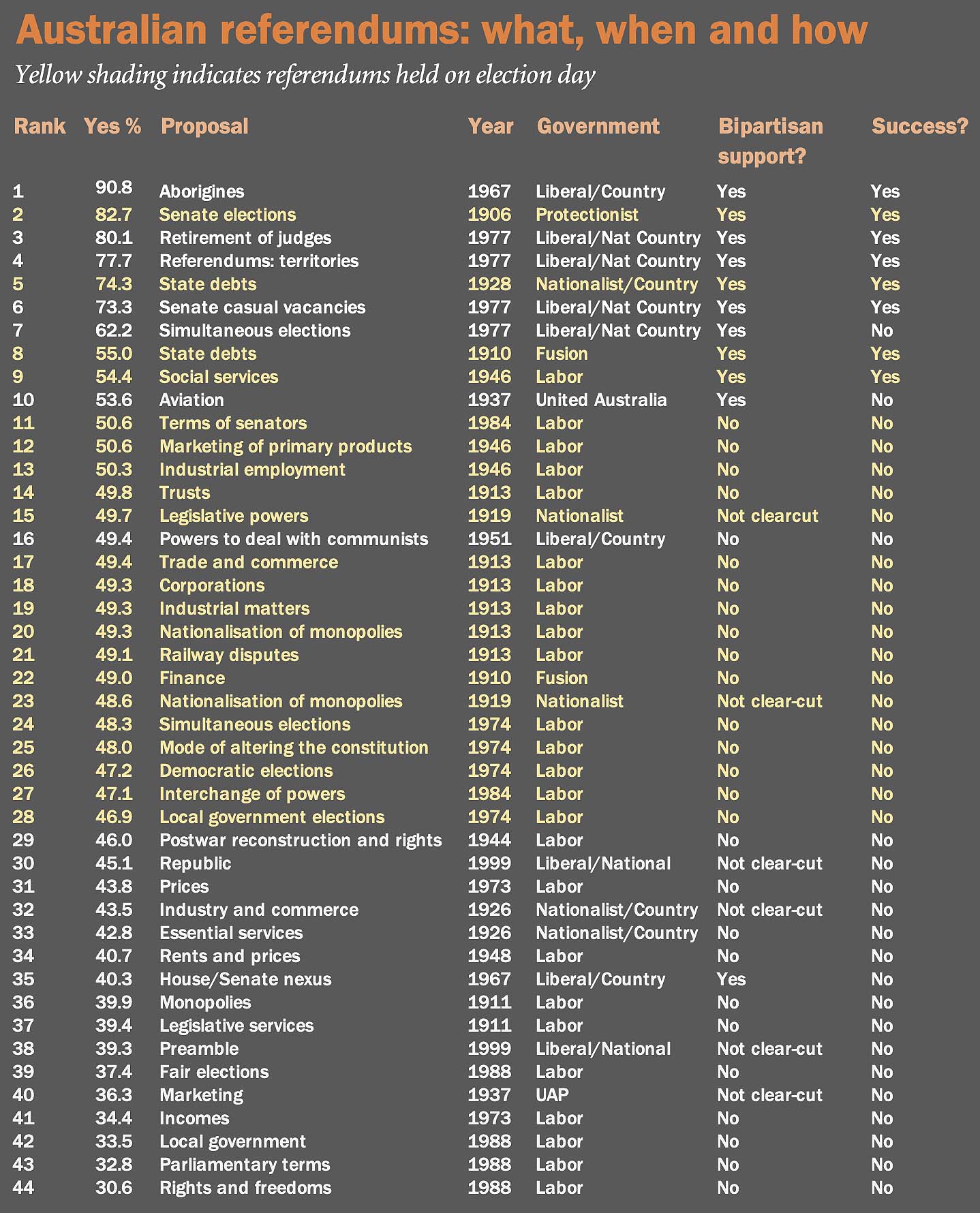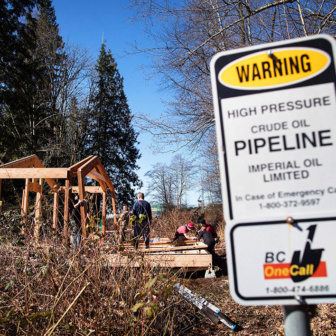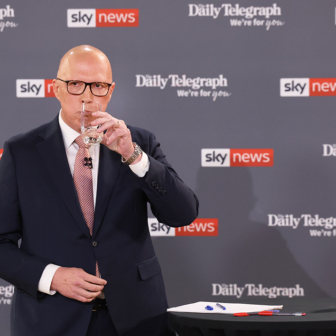Was the famous 1967 “Aborigines” referendum question the most misleading in Australian constitutional history?
Australians were asked this question:
Do you approve the proposed law for the alteration of the Constitution entitled — “An Act to alter the Constitution so as to omit certain words relating to the People of the Aboriginal Race in any State and so that Aboriginals are to be counted in reckoning the Population”?
The authors didn’t so much bury the lede as erase it. The second part — the bit after the “and” — was reasonably straightforward, conceptually at least, and is what most people remember today. But the first and much more important part coyly described a plan to “omit certain words relating to the People of the Aboriginal Race in any State.” Is it too cynical to assume that voters were meant to skip the “and” and assume it was all about counting?
A half-honest formulation would at least have mentioned that a Yes would give the federal government powers to legislate specifically for “aborigines” (in the nomenclature of the time). But the ballot paper was of a piece with the whole campaign, which referred to equality or simply to a “Yes for aborigines.” The politicians and advocates made a decision to de-emphasise the positive discrimination. Too hard, too potentially contentious.
Because no one voted against the legislation in parliament, there was no publicly funded No case to make that point. And most attention was on the accompanying referendum, the first on the ballot paper, which dealt with the link between how many MPs sit in the House of Representatives and how many in the Senate. (Despite also receiving bipartisan support, that one went down badly.)
The amendment’s importance lay in its kickstarting of the long-dormant “race power.” In subsequent decades that power facilitated land rights legislation, Abstudy, the Aboriginal Medical Service, Aboriginal and Torres Strait Islander legal services and other policies.
Now, in the 2020s, referendum talk is in the air again. Four years ago, on the fiftieth anniversary of that 1967 milestone, the First Nations National Constitutional Convention released the Uluru Statement from the Heart, a major recommendation of which is to include a First Nations Voice into our constitutional arrangements. It’s a far cry from the “minimalist” model that had been doing the rounds, which would have taken references to “race” out of the Constitution, replaced the “race power” with one specifically referring to the advancement of Indigenous Australians, and inserted some words describing the tens of thousands of years of Indigenous life on this continent.
What are the chances of inserting the Voice into the Constitution? The track record of referendums since 1901, eight successes out of forty-four attempts, gives some indication. And this time a one-sided game, like in 1967, won’t be possible. There will certainly be a No case.
In a perfect world, referendums would involve reason and dialogue and appealing to people’s better natures. In practice they’re like elections, mostly relying on emotion fuelled by snippets of information. By-elections are a better template, because who governs is not at stake, which frees people up to give the government a bloody nose if they’re so inclined.
It’s no accident that midterm referendums held without opposition support have generally done particularly poorly. As a rule (with 1967 an exception) questions put at the same time, on very different topics, have attracted similar levels of support, which doesn’t suggest an engaged populace carefully considering the merits of proposals. This is the Constitution, after all, a document a long way from most people’s daily thoughts, and most attempted amendments are incredibly arcane and, to the voter, seemingly gratuitous. We’ve survived this long without this change, why the need now?
In the first decade of federation, referendums were held with general elections. As you would. Two out of three passed. With the ink on the 1900 document still drying, it was easier to argue for some tweaking. Then the two-party system developed, Labor took office with very ambitious plans for nationalisation and centralisation of power, and the midterm referendum habit was born. Politicians began to believe referendums would only complicate election campaigns, making bipartisanship difficult. Fair enough, but then bipartisanship has been rare between elections as well, and all but non-existent if Labor is in government. About half our referendums have been held midterm.
The overriding dynamic from around 1910 to 1990 was that Labor was in favour of constitutional change — almost any change (apart from 1951 to ban communism) — to freshen up the document, make it live and breathe, and, in the early years at least, deliver more power to the central government. The Coalition tended to oppose, largely in response to the latter.
Much of this disagreement reflected the content of the proposed amendments, but the parties’ attitudes hardened into matters of identity. Liberals would oppose something in opposition, and then in government propose the same. The upshot is that Labor oppositions have usually supported constitutional referendums, while the anti-Labor parties in opposition have not.
In fact, Liberal opposition leaders find it almost impossible to back a Labor-initiated change. They simply lack the authority. The planned referendum to recognise local government with the 2013 election is a textbook example: Tony Abbott was fully signed up until a late mini-rebellion from the party room and the wider conservative movement forced him to back out.
Then, from the 1990s, Labor began losing its enthusiasm for constitutional reform for its own sake. It was John Howard who launched the 1999 republic referendum, and its forgotten preamble partner. And, once a year or so, he would raise the idea of fixed four-year terms — popular with business groups — but it would dissolve within days, if not hours.
Kevin Rudd played with the idea of a referendum on health, but mostly as a political threat.
This table has every one of Australia’s constitutional referendums, in descending order of national vote. Three achieved national majorities but not the majority in a majority of states. The colour-coding shows whether they were held midterm (white) or with an election (yellow).

A couple of take-outs. First, see numbers 7 and 24 for one example of the importance of bipartisan support, and of the Coalition’s tune-changing once in office.
We know the golden rule by heart: bipartisan support has been a necessary though not sufficient condition for referendum success. But timing has been a largely unacknowledged but crucial driver of popular support.
Down the bottom of the table, the least successful referendums — sixteen of them, mostly without bipartisan support — were held midterm. Further up, a big bunch held with elections, almost all by Labor governments (non-Labor haven’t held a referendum with an election since 1919), still failed, but more respectably. With the election campaign gobbling the oxygen, the referendums tend to be little-discussed. In the end the Yes vote has approximated the government’s primary vote. Three received national majorities but clipped the “double majority” hurdle.
So what are the paths to success for the Voice? Ideally it would be held with the next general election, with bipartisan support. But that timing isn’t on the table. Two broad trajectories will be on offer after the election, in late 2021 or early 2022: a re-elected Coalition government and a new Labor one.
Under the first scenario, the win would probably reinvigorate Scott Morrison’s party-room stature and he might be convinced to, with the help of allies, drag the Coalition behind him on the Voice. The Labor opposition would probably support him, a midterm referendum would be held — and its chances would be pretty good.
And if Labor wins? While that would make the holding of a referendum more likely, the chances of victory would shrink dramatically because you can all but rule out opposition support. A midterm referendum would almost certainly crash, but what about one held with the following election (in 2024–25)? That would certainly stand a better chance. A required ingredient would be a big Labor re-election, and we haven’t seen one of those at federal level since 1946, which as it happens was the scene of Labor’s one and only referendum success.
But the bottom line is that a Coalition government is more likely to deliver the Voice than a Labor one. “Nixon to China” and so on.
This all sounds terribly reductionist and deterministic. It does downplay the importance of content, argument, Australians’ willingness to do good, and the energy and force of the Yes and No campaigns. But it doesn’t discount them altogether. All these will be important, but so will timing.
Creating the Voice is the main game. The accessories, the stories told about it, the why and how Australians voted as they did can be invented afterwards. As Tim Rowse recently described, the myths around 1967, not all of them based on reality, have their uses. So too would a successful Voice vote. But mythology is of little help in getting us there. •





